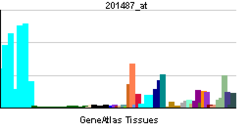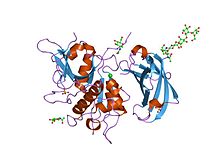- Cathepsin C
-
Cathepsin C 
PDB rendering based on 1k3b.Available structures PDB 1K3B, 2DJF, 2DJG Identifiers Symbols CTSC; CPPI; DPP1; DPPI; HMS; JP; JPD; PALS; PLS External IDs OMIM: 602365 MGI: 109553 HomoloGene: 1373 GeneCards: CTSC Gene EC number 3.4.14.1 Gene Ontology Molecular function • cysteine-type endopeptidase activity
• peptidase activity
• chloride ion binding
• identical protein binding
• protein self-associationCellular component • lysosome
• endoplasmic reticulum
• Golgi apparatusBiological process • proteolysis
• immune response
• aging
• response to organic substanceSources: Amigo / QuickGO RNA expression pattern 
More reference expression data Orthologs Species Human Mouse Entrez 1075 13032 Ensembl ENSG00000109861 ENSMUSG00000030560 UniProt P53634 Q3TIF1 RefSeq (mRNA) NM_001114173.1 NM_009982.4 RefSeq (protein) NP_001107645.1 NP_034112.3 Location (UCSC) Chr 11:
88.03 – 88.07 MbChr 7:
95.43 – 95.46 MbPubMed search [1] [2] Cathepsin C exclusion domain 
re-determination of the native structure of human dipeptidyl peptidase i (cathepsin c) Identifiers Symbol CathepsinC_exc Pfam PF08773 InterPro IPR014882 SCOP 1k3b Available protein structures: Pfam structures PDB RCSB PDB; PDBe PDBsum structure summary Cathepsin C (CTSC) also known as dipeptidyl peptidase I (DPP-I) is a lysosomal exo-cysteine protease belonging to the peptidase C1 family. In humans, it is encoded by the CTSC gene.[1][2]
Contents
Function
Cathepsin C appears to be a central coordinator for activation of many serine proteases in immune/inflammatory cells.
Cathepsin C catalyses excision of dipeptides from the N-terminus of protein and peptide substrates, except if (i) the amino group of the N-terminus is blocked, (ii) the site of cleavage is on either side of a proline residue, (iii) the N-terminal residue is lysine or arginine, or (iv) the structure of the peptide or protein prevents further digestion from the N-terminus.
Structure
The cDNAs encoding rat, human, murine, bovine, dog and two Schistosome cathepsin Cs have been cloned and sequenced and show that the enzyme is highly conserved.[3] The human and rat cathepsin C cDNAs encode precursors (prepro-cathepsin C) comprising signal peptides of 24 residues, pro-regions of 205 (rat cathepsin C) or 206 (human cathepsin C) residues and catalytic domains of 233 residues which contain the catalytic residues and are 30-40% identical to the mature amino acid sequences of papain and a number of other cathepsins including cathepsins, B, H, K, L, and S.[4]
The translated prepro-cathepsin C is processed into the mature form by at least four cleavages of the polypeptide chain. The signal peptide is removed during translocation or secretion of the pro-enzyme (pro-cathepsin C) and a large N-terminal proregion fragment (also known as the exclusion domain),[5] which is retained in the mature enzyme, is separated from the catalytic domain by excision of a minor C-terminal part of the pro-region, called the activation peptide. A heavy chain of about 164 residues and a light chain of about 69 residues are generated by cleavage of the catalytic domain.
Unlike the other members of the papain family, mature cathepsin C consists of four subunits, each composed of the N-terminal proregion fragment, the heavy chain and the light chain. Both the pro-region fragment and the heavy chain are glycosylated.
Clinical significance
Defects in the encoded protein have been shown to be a cause of Papillon-Lefevre disease,[6][7] an autosomal recessive disorder characterized by palmoplantar keratosis and periodontitis.
Cathepsin C functions as a key enzyme in the activation of granule serine peptidases in inflammatory cells, such as elastase and cathepsin G in neutrophils cells and chymase and tryptase in mast cells. In many inflammatory diseases, such as Rheumatoid Arthritis, Chronic Obstructive Pulmonary Disease (COPD), Inflammatory Bowel Disease, Asthma, Sepsis and Cystic Fibrosis, a significant part of the pathogenesis is caused by increased activity of some of these inflammatory proteases. Once activated by cathepsin C, the proteases are capable of degrading various extracellular matrix components, which can lead to tissue damage and chronic inflammation.
References
- ^ "Entrez Gene: CTSC cathepsin C". http://www.ncbi.nlm.nih.gov/sites/entrez?Db=gene&Cmd=ShowDetailView&TermToSearch=1075.
- ^ Paris A, Strukelj B, Pungercar J, Renko M, Dolenc I, Turk V (August 1995). "Molecular cloning and sequence analysis of human preprocathepsin C". FEBS Letters 369 (2–3): 326–30. doi:10.1016/0014-5793(95)00777-7. PMID 7649281.
- ^ Hola-Jamriska L, Tort JF, Dalton JP, Day SR, Fan J, Aaskov J, Brindley PJ (August 1998). "Cathepsin C from Schistosoma japonicum--cDNA encoding the preproenzyme and its phylogenetic relationships". European Journal of Biochemistry / FEBS 255 (3): 527–34. doi:10.1046/j.1432-1327.1998.2550527.x. PMID 9738890.
- ^ Kominami E, Ishido K, Muno D, Sato N (July 1992). "The primary structure and tissue distribution of cathepsin C". Biological Chemistry Hoppe-Seyler 373 (7): 367–73. PMID 1515062.
- ^ Turk, D.; Janjić, V.; Stern, I.; Podobnik, M.; Lamba, D.; Dahl, S. W.; Lauritzen, C.; Pedersen, J. et al. (2001). "Structure of human dipeptidyl peptidase I (cathepsin C): Exclusion domain added to an endopeptidase framework creates the machine for activation of granular serine proteases". The EMBO Journal 20 (23): 6570–6582. doi:10.1093/emboj/20.23.6570. PMC 125750. PMID 11726493. http://www.pubmedcentral.nih.gov/articlerender.fcgi?tool=pmcentrez&artid=125750.
- ^ Wani AA, Devkar N, Patole MS, Shouche YS (2006). "Description of two new cathepsin C gene mutations in patients with Papillon-Lefèvre syndrome". J. Periodontol. 77 (2): 233–7. doi:10.1902/jop.2006.050124. PMID 16460249.
- ^ Meade JL, de Wynter EA, Brett P, Sharif SM, Woods CG, Markham AF, Cook GP (2006). "A family with Papillon-Lefevre syndrome reveals a requirement for cathepsin C in granzyme B activation and NK cell cytolytic activity". Blood 107 (9): 3665–3668. doi:10.1182/blood-2005-03-1140. PMID 16410452.
Further reading
- McGuire MJ, Lipsky PE, Thiele DL (1992). "Purification and characterization of dipeptidyl peptidase I from human spleen". Arch. Biochem. Biophys. 295 (2): 280–8. doi:10.1016/0003-9861(92)90519-3. PMID 1586157.
- Paris A, Strukelj B, Pungercar J, et al. (1995). "Molecular cloning and sequence analysis of human preprocathepsin C". FEBS Lett. 369 (2–3): 326–30. doi:10.1016/0014-5793(95)00777-7. PMID 7649281.
- Dolenc I, Turk B, Pungercic G, et al. (1995). "Oligomeric structure and substrate induced inhibition of human cathepsin C". J. Biol. Chem. 270 (37): 21626–31. doi:10.1074/jbc.270.37.21626. PMID 7665576.
- Maruyama K, Sugano S (1994). "Oligo-capping: a simple method to replace the cap structure of eukaryotic mRNAs with oligoribonucleotides". Gene 138 (1–2): 171–4. doi:10.1016/0378-1119(94)90802-8. PMID 8125298.
- Rao NV, Rao GV, Hoidal JR (1997). "Human dipeptidyl-peptidase I. Gene characterization, localization, and expression". J. Biol. Chem. 272 (15): 10260–5. doi:10.1074/jbc.272.15.10260. PMID 9092576.
- Fischer J, Blanchet-Bardon C, Prud'homme JF, et al. (1997). "Mapping of Papillon-Lefevre syndrome to the chromosome 11q14 region". Eur. J. Hum. Genet. 5 (3): 156–60. PMID 9272739.
- Suzuki Y, Yoshitomo-Nakagawa K, Maruyama K, et al. (1997). "Construction and characterization of a full length-enriched and a 5'-end-enriched cDNA library". Gene 200 (1–2): 149–56. doi:10.1016/S0378-1119(97)00411-3. PMID 9373149.
- Cigić B, Krizaj I, Kralj B, et al. (1998). "Stoichiometry and heterogeneity of the pro-region chain in tetrameric human cathepsin C". Biochim. Biophys. Acta 1382 (1): 143–50. doi:10.1016/S0167-4838(97)00173-8. PMID 9507095.
- Toomes C, James J, Wood AJ, et al. (1999). "Loss-of-function mutations in the cathepsin C gene result in periodontal disease and palmoplantar keratosis". Nat. Genet. 23 (4): 421–4. doi:10.1038/70525. PMID 10581027.
- Hart TC, Hart PS, Bowden DW, et al. (2000). "Mutations of the cathepsin C gene are responsible for Papillon-Lefèvre syndrome". J. Med. Genet. 36 (12): 881–7. doi:10.1136/jmg.36.12.881. PMC 1734286. PMID 10593994. http://www.pubmedcentral.nih.gov/articlerender.fcgi?tool=pmcentrez&artid=1734286.
- Hart TC, Hart PS, Michalec MD, et al. (2000). "Haim-Munk syndrome and Papillon-Lefèvre syndrome are allelic mutations in cathepsin C". J. Med. Genet. 37 (2): 88–94. doi:10.1136/jmg.37.2.88. PMC 1734521. PMID 10662807. http://www.pubmedcentral.nih.gov/articlerender.fcgi?tool=pmcentrez&artid=1734521.
- Hart TC, Hart PS, Michalec MD, et al. (2000). "Localisation of a gene for prepubertal periodontitis to chromosome 11q14 and identification of a cathepsin C gene mutation". J. Med. Genet. 37 (2): 95–101. doi:10.1136/jmg.37.2.95. PMC 1734516. PMID 10662808. http://www.pubmedcentral.nih.gov/articlerender.fcgi?tool=pmcentrez&artid=1734516.
- Suzuki Y, Ishihara D, Sasaki M, et al. (2000). "Statistical analysis of the 5' untranslated region of human mRNA using "Oligo-Capped" cDNA libraries". Genomics 64 (3): 286–97. doi:10.1006/geno.2000.6076. PMID 10756096.
- Cigić B, Dahl SW, Pain RH (2000). "The residual pro-part of cathepsin C fulfills the criteria required for an intramolecular chaperone in folding and stabilizing the human proenzyme". Biochemistry 39 (40): 12382–90. doi:10.1021/bi0008837. PMID 11015218.
- Hartley JL, Temple GF, Brasch MA (2001). "DNA cloning using in vitro site-specific recombination". Genome Res. 10 (11): 1788–1795. doi:10.1101/gr.143000. PMC 310948. PMID 11076863. http://www.pubmedcentral.nih.gov/articlerender.fcgi?tool=pmcentrez&artid=310948.
- Hart PS, Zhang Y, Firatli E, et al. (2001). "Identification of cathepsin C mutations in ethnically diverse papillon-Lefèvre syndrome patients". J. Med. Genet. 37 (12): 927–32. doi:10.1136/jmg.37.12.927. PMC 1734492. PMID 11106356. http://www.pubmedcentral.nih.gov/articlerender.fcgi?tool=pmcentrez&artid=1734492.
- Zhang Y, Lundgren T, Renvert S, et al. (2001). "Evidence of a founder effect for four cathepsin C gene mutations in Papillon-Lefèvre syndrome patients". J. Med. Genet. 38 (2): 96–101. doi:10.1136/jmg.38.2.96. PMC 1734811. PMID 11158173. http://www.pubmedcentral.nih.gov/articlerender.fcgi?tool=pmcentrez&artid=1734811.
- Nakano A, Nomura K, Nakano H, et al. (2001). "Papillon-Lefèvre syndrome: mutations and polymorphisms in the cathepsin C gene". J. Invest. Dermatol. 116 (2): 339–43. doi:10.1046/j.1523-1747.2001.01244.x. PMID 11180012.
- Allende LM, García-Pérez MA, Moreno A, et al. (2001). "Cathepsin C gene: First compound heterozygous patient with Papillon-Lefèvre syndrome and a novel symptomless mutation". Hum. Mutat. 17 (2): 152–3. doi:10.1002/1098-1004(200102)17:2<152::AID-HUMU10>3.0.CO;2-#. PMID 11180601.
- Wiemann S, Weil B, Wellenreuther R, et al. (2001). "Toward a catalog of human genes and proteins: sequencing and analysis of 500 novel complete protein coding human cDNAs". Genome Res. 11 (3): 422–35. doi:10.1101/gr.GR1547R. PMC 311072. PMID 11230166. http://www.pubmedcentral.nih.gov/articlerender.fcgi?tool=pmcentrez&artid=311072.
External links
- The MEROPS online database for peptidases and their inhibitors: C01.070
- MeSH Cathepsin+C
PDB gallery 1k3b: Crystal Structure of Human Dipeptidyl Peptidase I (Cathepsin C): Exclusion Domain Added to an Endopeptidase Framework Creates the Machine for Activation of Granular Serine Proteases2djf: Crystal Structure of human dipeptidyl peptidase I (Cathepsin C) in complex with the inhibitor Gly-Phe-CHN22djg: Re-determination of the native structure of human dipeptidyl peptidase I (cathepsin C)Caspase Caspase 1 · Caspase 2 · Caspase 3 · Caspase 4 · Caspase 5 · Caspase 6 · Caspase 7 · Caspase 8 · Caspase 9 · Caspase 10 · Caspase 12 · Caspase 13 · Caspase 14Fruit-derived Calpain Cathepsin Other Categories:- Human proteins
- Proteins
- Peptidase
- EC 3.4.14
Wikimedia Foundation. 2010.



